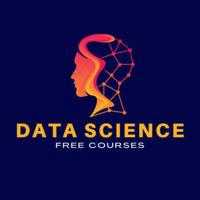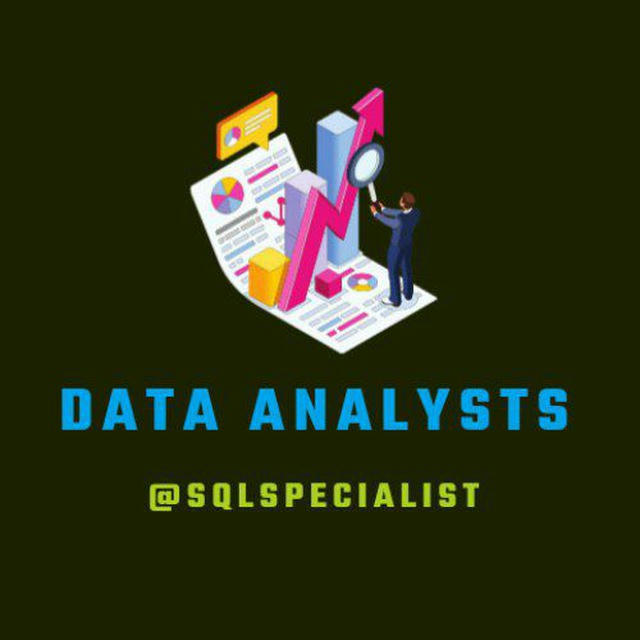
Data Scientists | Machine Learning | AI Chatbots | Artificial Intelligence
Perfect channel to learn Data Analytics, Data Sciene, Machine Learning & Artificial Intelligence Promotions: @coderfun Buy ads: https://telega.io/c/datasciencefree
نمایش بیشتر36 641
مشترکین
+22424 ساعت
+1 2247 روز
+4 79230 روز
- مشترکین
- پوشش پست
- ER - نسبت تعامل
در حال بارگیری داده...
معدل نمو المشتركين
در حال بارگیری داده...
Complete Machine Learning Roadmap
👇👇
1. Introduction to Machine Learning
- Definition
- Purpose
- Types of Machine Learning (Supervised, Unsupervised, Reinforcement)
2. Mathematics for Machine Learning
- Linear Algebra
- Calculus
- Statistics and Probability
3. Programming Languages for ML
- Python and Libraries (NumPy, Pandas, Matplotlib)
- R
4. Data Preprocessing
- Handling Missing Data
- Feature Scaling
- Data Transformation
5. Exploratory Data Analysis (EDA)
- Data Visualization
- Descriptive Statistics
6. Supervised Learning
- Regression
- Classification
- Model Evaluation
7. Unsupervised Learning
- Clustering (K-Means, Hierarchical)
- Dimensionality Reduction (PCA)
8. Model Selection and Evaluation
- Cross-Validation
- Hyperparameter Tuning
- Evaluation Metrics (Precision, Recall, F1 Score)
9. Ensemble Learning
- Random Forest
- Gradient Boosting
10. Neural Networks and Deep Learning
- Introduction to Neural Networks
- Building and Training Neural Networks
- Convolutional Neural Networks (CNN)
- Recurrent Neural Networks (RNN)
11. Natural Language Processing (NLP)
- Text Preprocessing
- Sentiment Analysis
- Named Entity Recognition (NER)
12. Reinforcement Learning
- Basics
- Markov Decision Processes
- Q-Learning
13. Machine Learning Frameworks
- TensorFlow
- PyTorch
- Scikit-Learn
14. Deployment of ML Models
- Flask for Web Deployment
- Docker and Kubernetes
15. Ethical and Responsible AI
- Bias and Fairness
- Ethical Considerations
16. Machine Learning in Production
- Model Monitoring
- Continuous Integration/Continuous Deployment (CI/CD)
17. Real-world Projects and Case Studies
18. Machine Learning Resources
- Online Courses
- Books
- Blogs and Journals
📚 Learning Resources for Machine Learning:
- [Python for Machine Learning](https://t.me/udacityfreecourse/167)
- [Fast.ai: Practical Deep Learning for Coders](https://course.fast.ai/)
- [Intro to Machine Learning](https://learn.microsoft.com/en-us/training/paths/intro-to-ml-with-python/)
📚 Books:
- Machine Learning Interviews
- Machine Learning for Absolute Beginners
📚 Join @free4unow_backup for more free resources.
ENJOY LEARNING! 👍👍
👍 6
Photo unavailableShow in Telegram
👍 2
Photo unavailableShow in Telegram
👍 13
Photo unavailableShow in Telegram
👍 21
Data Scientist Roadmap
|
|-- 1. Basic Foundations
| |-- a. Mathematics
| | |-- i. Linear Algebra
| | |-- ii. Calculus
| | |-- iii. Probability
| |
-- iv. Statistics
| |
| |-- b. Programming
| | |-- i. Python
| | | |-- 1. Syntax and Basic Concepts
| | | |-- 2. Data Structures
| | | |-- 3. Control Structures
| | | |-- 4. Functions
| | | -- 5. Object-Oriented Programming
| | |
| | -- ii. R (optional, based on preference)
| |
| |-- c. Data Manipulation
| | |-- i. Numpy (Python)
| | |-- ii. Pandas (Python)
| | -- iii. Dplyr (R)
| |
| -- d. Data Visualization
| |-- i. Matplotlib (Python)
| |-- ii. Seaborn (Python)
| -- iii. ggplot2 (R)
|
|-- 2. Data Exploration and Preprocessing
| |-- a. Exploratory Data Analysis (EDA)
| |-- b. Feature Engineering
| |-- c. Data Cleaning
| |-- d. Handling Missing Data
| -- e. Data Scaling and Normalization
|
|-- 3. Machine Learning
| |-- a. Supervised Learning
| | |-- i. Regression
| | | |-- 1. Linear Regression
| | | -- 2. Polynomial Regression
| | |
| | -- ii. Classification
| | |-- 1. Logistic Regression
| | |-- 2. k-Nearest Neighbors
| | |-- 3. Support Vector Machines
| | |-- 4. Decision Trees
| | -- 5. Random Forest
| |
| |-- b. Unsupervised Learning
| | |-- i. Clustering
| | | |-- 1. K-means
| | | |-- 2. DBSCAN
| | | -- 3. Hierarchical Clustering
| | |
| | -- ii. Dimensionality Reduction
| | |-- 1. Principal Component Analysis (PCA)
| | |-- 2. t-Distributed Stochastic Neighbor Embedding (t-SNE)
| | -- 3. Linear Discriminant Analysis (LDA)
| |
| |-- c. Reinforcement Learning
| |-- d. Model Evaluation and Validation
| | |-- i. Cross-validation
| | |-- ii. Hyperparameter Tuning
| | -- iii. Model Selection
| |
| -- e. ML Libraries and Frameworks
| |-- i. Scikit-learn (Python)
| |-- ii. TensorFlow (Python)
| |-- iii. Keras (Python)
| -- iv. PyTorch (Python)
|
|-- 4. Deep Learning
| |-- a. Neural Networks
| | |-- i. Perceptron
| | -- ii. Multi-Layer Perceptron
| |
| |-- b. Convolutional Neural Networks (CNNs)
| | |-- i. Image Classification
| | |-- ii. Object Detection
| | -- iii. Image Segmentation
| |
| |-- c. Recurrent Neural Networks (RNNs)
| | |-- i. Sequence-to-Sequence Models
| | |-- ii. Text Classification
| | -- iii. Sentiment Analysis
| |
| |-- d. Long Short-Term Memory (LSTM) and Gated Recurrent Units (GRU)
| | |-- i. Time Series Forecasting
| | -- ii. Language Modeling
| |
| -- e. Generative Adversarial Networks (GANs)
| |-- i. Image Synthesis
| |-- ii. Style Transfer
| -- iii. Data Augmentation
|
|-- 5. Big Data Technologies
| |-- a. Hadoop
| | |-- i. HDFS
| | -- ii. MapReduce
| |
| |-- b. Spark
| | |-- i. RDDs
| | |-- ii. DataFrames
| | -- iii. MLlib
| |
| -- c. NoSQL Databases
| |-- i. MongoDB
| |-- ii. Cassandra
| |-- iii. HBase
| -- iv. Couchbase
|
|-- 6. Data Visualization and Reporting
| |-- a. Dashboarding Tools
| | |-- i. Tableau
| | |-- ii. Power BI
| | |-- iii. Dash (Python)
| | -- iv. Shiny (R)
| |
| |-- b. Storytelling with Data
| -- c. Effective Communication
|
|-- 7. Domain Knowledge and Soft Skills
| |-- a. Industry-specific Knowledge
| |-- b. Problem-solving
| |-- c. Communication Skills
| |-- d. Time Management
| -- e. Teamwork
|
-- 8. Staying Updated and Continuous Learning
|-- a. Online Courses
|-- b. Books and Research Papers
|-- c. Blogs and Podcasts
|-- d. Conferences and Workshops
`-- e. Networking and Community Engagement
Best Data Science & Machine Learning Resources: https://topmate.io/coding/914624
All the best 👍👍👍 26
Photo unavailableShow in Telegram
👍 28
Complete roadmap to learn data science in 2024 👇👇
1. Learn the Basics:
- Brush up on your mathematics, especially statistics.
- Familiarize yourself with programming languages like Python or R.
- Understand basic concepts in databases and data manipulation.
2. Programming Proficiency:
- Develop strong programming skills, particularly in Python or R.
- Learn data manipulation libraries (e.g., Pandas) and visualization tools (e.g., Matplotlib, Seaborn).
3. Statistics and Mathematics:
- Deepen your understanding of statistical concepts.
- Explore linear algebra and calculus, especially for machine learning.
4. Data Exploration and Preprocessing:
- Practice exploratory data analysis (EDA) techniques.
- Learn how to handle missing data and outliers.
5. Machine Learning Fundamentals:
- Understand basic machine learning algorithms (e.g., linear regression, decision trees).
- Learn how to evaluate model performance.
6. Advanced Machine Learning:
- Dive into more complex algorithms (e.g., SVM, neural networks).
- Explore ensemble methods and deep learning.
7. Big Data Technologies:
- Familiarize yourself with big data tools like Apache Hadoop and Spark.
- Learn distributed computing concepts.
8. Feature Engineering and Selection:
- Master techniques for creating and selecting relevant features in your data.
9. Model Deployment:
- Understand how to deploy machine learning models to production.
- Explore containerization and cloud services.
10. Version Control and Collaboration:
- Use version control systems like Git.
- Collaborate with others using platforms like GitHub.
11. Stay Updated:
- Keep up with the latest developments in data science and machine learning.
- Participate in online communities, read research papers, and attend conferences.
12. Build a Portfolio:
- Showcase your projects on platforms like GitHub.
- Develop a portfolio demonstrating your skills and expertise.
Best Resources to learn Data Science
Intro to Data Analytics by Udacity
Machine Learning course by Google
Machine Learning with Python
Data Science Interview Questions
Data Science Project ideas
Data Science: Linear Regression Course by Harvard
Machine Learning Interview Questions
Free Datasets for Projects
Please give us credits while sharing: -> https://t.me/free4unow_backup
ENJOY LEARNING 👍👍
👍 13👎 1
Complete Machine Learning Roadmap
👇👇
1. Introduction to Machine Learning
- Definition
- Purpose
- Types of Machine Learning (Supervised, Unsupervised, Reinforcement)
2. Mathematics for Machine Learning
- Linear Algebra
- Calculus
- Statistics and Probability
3. Programming Languages for ML
- Python and Libraries (NumPy, Pandas, Matplotlib)
- R
4. Data Preprocessing
- Handling Missing Data
- Feature Scaling
- Data Transformation
5. Exploratory Data Analysis (EDA)
- Data Visualization
- Descriptive Statistics
6. Supervised Learning
- Regression
- Classification
- Model Evaluation
7. Unsupervised Learning
- Clustering (K-Means, Hierarchical)
- Dimensionality Reduction (PCA)
8. Model Selection and Evaluation
- Cross-Validation
- Hyperparameter Tuning
- Evaluation Metrics (Precision, Recall, F1 Score)
9. Ensemble Learning
- Random Forest
- Gradient Boosting
10. Neural Networks and Deep Learning
- Introduction to Neural Networks
- Building and Training Neural Networks
- Convolutional Neural Networks (CNN)
- Recurrent Neural Networks (RNN)
11. Natural Language Processing (NLP)
- Text Preprocessing
- Sentiment Analysis
- Named Entity Recognition (NER)
12. Reinforcement Learning
- Basics
- Markov Decision Processes
- Q-Learning
13. Machine Learning Frameworks
- TensorFlow
- PyTorch
- Scikit-Learn
14. Deployment of ML Models
- Flask for Web Deployment
- Docker and Kubernetes
15. Ethical and Responsible AI
- Bias and Fairness
- Ethical Considerations
16. Machine Learning in Production
- Model Monitoring
- Continuous Integration/Continuous Deployment (CI/CD)
17. Real-world Projects and Case Studies
18. Machine Learning Resources
- Online Courses
- Books
- Blogs and Journals
📚 Learning Resources for Machine Learning:
- [Python for Machine Learning](https://t.me/udacityfreecourse/167)
- [Fast.ai: Practical Deep Learning for Coders](https://course.fast.ai/)
- [Intro to Machine Learning](https://learn.microsoft.com/en-us/training/paths/intro-to-ml-with-python/)
📚 Books:
- Machine Learning Interviews
- Machine Learning for Absolute Beginners
📚 Join @free4unow_backup for more free resources.
ENJOY LEARNING! 👍👍
👍 18👎 1
Common Machine Learning Algorithms!
1️⃣ Linear Regression
->Used for predicting continuous values.
->Models the relationship between dependent and independent variables by fitting a linear equation.
2️⃣ Logistic Regression
->Ideal for binary classification problems.
->Estimates the probability that an instance belongs to a particular class.
3️⃣ Decision Trees
->Splits data into subsets based on the value of input features.
->Easy to visualize and interpret but can be prone to overfitting.
4️⃣ Random Forest
->An ensemble method using multiple decision trees.
->Reduces overfitting and improves accuracy by averaging multiple trees.
5️⃣ Support Vector Machines (SVM)
->Finds the hyperplane that best separates different classes.
->Effective in high-dimensional spaces and for classification tasks.
6️⃣ k-Nearest Neighbors (k-NN)
->Classifies data based on the majority class among the k-nearest neighbors.
->Simple and intuitive but can be computationally intensive.
7️⃣ K-Means Clustering
->Partitions data into k clusters based on feature similarity.
->Useful for market segmentation, image compression, and more.
8️⃣ Naive Bayes
->Based on Bayes' theorem with an assumption of independence among predictors.
->Particularly useful for text classification and spam filtering.
9️⃣ Neural Networks
->Mimic the human brain to identify patterns in data.
->Power deep learning applications, from image recognition to natural language processing.
🔟 Gradient Boosting Machines (GBM)
->Combines weak learners to create a strong predictive model.
->Used in various applications like ranking, classification, and regression.
👍 11
یک طرح متفاوت انتخاب کنید
طرح فعلی شما تنها برای 5 کانال تجزیه و تحلیل را مجاز می کند. برای بیشتر، لطفا یک طرح دیگر انتخاب کنید.

 Network:
Network: